
Red Flag Species – Part 2
Red Flag Species
Part 2: Livestock
By Georgia Wingfield-Hayes
In the previous article on Red Flag Species we looked at plants such as docks, nettles and thistles, that we habitually don’t like to see in our fields. We discussed how, rather than just seeing these as problems that need to be got rid of, that they indicate to us underlying imbalance in nature’s dynamic networks. We recognised that in some way we are creating the perfect conditions for these red flag species to thrive. Why are they having such a good time?
With this different way of looking at a problem we can discover how a change in management can create conditions that are less favourable to such species, while creating more diversity in the farm ecosystem.
In this article we are going to take a similar look at a few prevalent problems experienced in livestock on farms. Again, rather than immediately assuming a conventional treatment will be needed to manage the problem, we will take a step back and try to understand what is going on to create the conditions for the given organism to thrive.
We are going to look at three classic problems: Ticks, and by implication the diseases that they spread; New Forest eye in cattle, and liver fluke. Liver fluke, ticks and tick borne diseases are all on the increase.
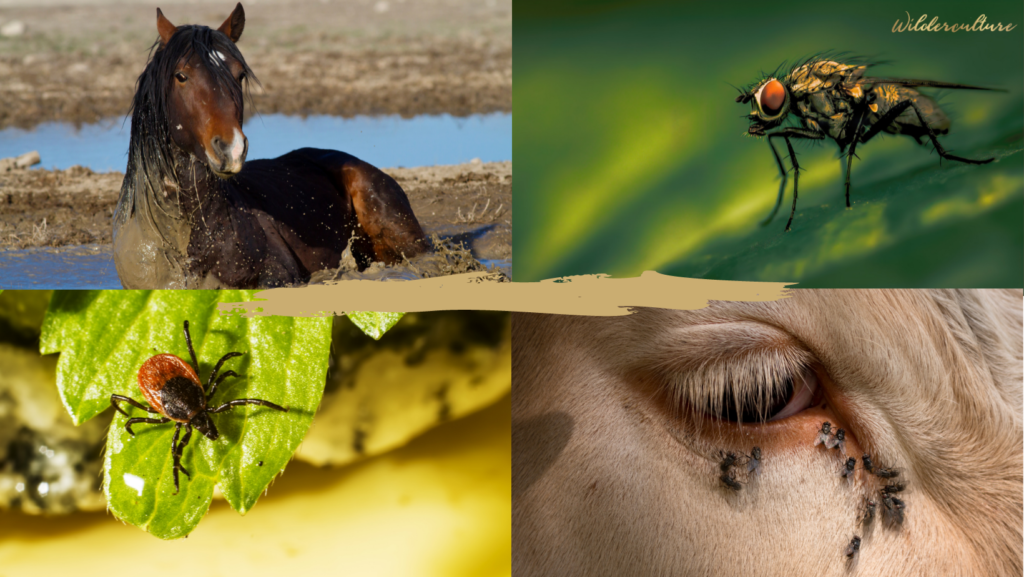
Ticks
Ticks are arthropods that spend most of their lives in the wider environment and short periods feeding on hosts – mostly mammals and birds. There are two families of ticks, Ixodidae being the most important one in terms of animal health. The most common species in the UK is Ixodes ricinus, commonly known as sheep tick.
Ixodid ticks have four life-stages: egg; six-legged larva; eight-legged nymph; and eight-legged adult. Once the egg has hatched the larva, nymph and adult require hosts of an ever increasing size; the adult seeking out large mammals to feed from. Each life stage takes around 3 years to complete. The larva and the nymph will feed on their host for 3-5 days. The adult male will feed intermittently on the host and move around mating with females, while an adult female will feed for around 14 days before dropping off and laying 1000’s of eggs in the soil over the following month, before she dies.
Ticks cause irritation to the skin and the sores can become infected and attract flies. Large infestations can even cause anaemia. But worst of all, ticks transmit viruses, bacteria and protozoa causing a whole host of diseases.
Ticks, although a nuisance to animals and humans alike, also play a role as a food source in the wider ecosystem. Many bird species including wader species, cattle egrets, quail, partridge, ducks, woodpeckers, and domestic fowl like chickens, will feed on ticks. There are species of moth, flies, ants, spiders, mites and beetles that will predate ticks. Also toads, tortoises, lizards, rats, mice and shrews are all potential predators. There are also mitosporic fungi, bacteria, protozoa, viruses and nematodes that are pathogenic to ticks.
Wild and domestic herbivores will self-groom and groom each other more when tick activity increases (spring and autumn, when conditions are warm and wet). Domestic livestock that are unable to, or have difficulty grooming, or in which these behavioural traits may have been affected by unnatural group structures perhaps will therefore be at a disadvantage.
Natural resistance to ticks is heritable but requires exposure to ticks to be activated. The histamine response creates irritation and therefore stimulates grooming, as well as the ticks being less likely to attach.
Resistance also seems to be stronger in wild herbivores than domestic, there could be many reasons for this: genetics, loss of agrobiodiversity, behaviours modified by social structures and environmental restrictions, nutrition and so on.
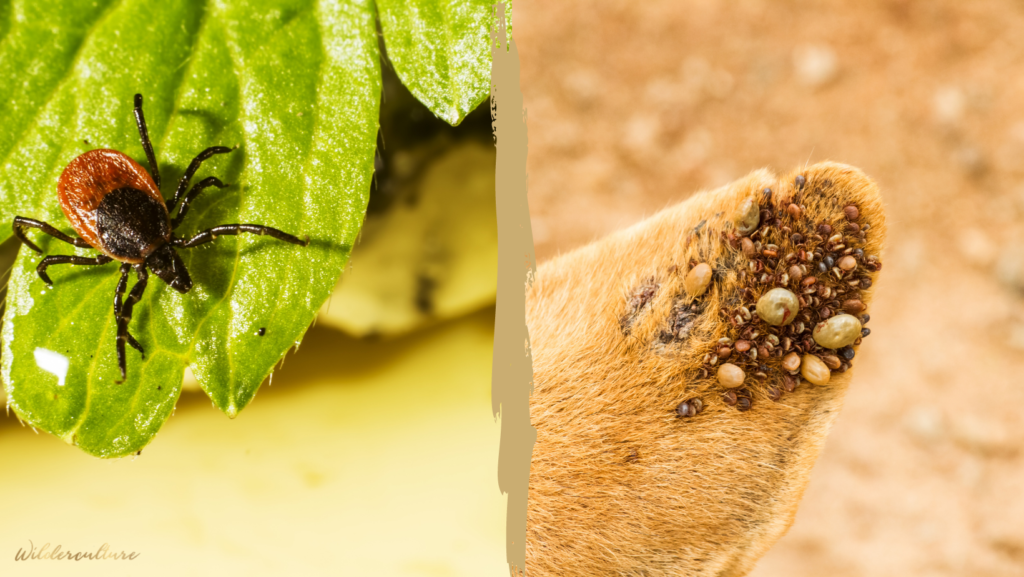
What is going on in the environment that is creating favourable conditions for ticks?
The most fundamental problems in our farming landscapes is the loss of biodiversity in the farm ecosystems as well as the loss of diversity in what is being farmed.
This loss of biodiversity means that the natural predators that would potentially consume large numbers of ticks, just aren’t there. The loss of diversity in the farming system means that fowl like chickens, rarely live alongside cows and sheep anymore.
In addition, we know that a more diverse diet of trees, herbs and shrubs in domestic livestock, enhances their immune system and their ability to fight off internal parasites, it may therefore be presumed that this will also increase their ability to fight off tick borne diseases.
Finally, wild and domestic animals alike will roll in dust and wallow in mud in order to combat skin parasites like ticks. Mud wallows as part of mosaic habitats will allow animals to roll and cover themselves in mud. As the mud dries it will pull the ticks from the skin. Wild animals have specific wallow sites that they visit for such purposes.
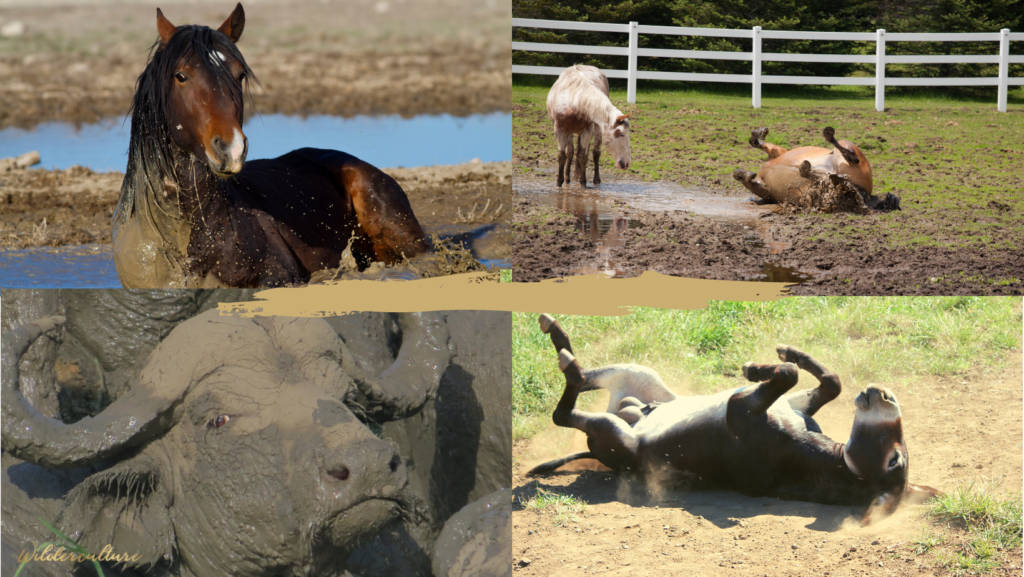
New Forest Eye
FAI’s farm in Wytham, Oxfordshire, during their initial transition to regenerative farming, had a problem with New Forest eye in their cattle. The FAI team, working alongside Caroline and Alex from Wilderculture, unpicked the problem using this red flag approach.
New Forest eye is caused by the bacteria Moraxella bovis, spread by flies (Musca autumnalis) when feeding on the secretions of the eyes of female cows. The bacteria can cause lesions in the eye that are painful and irritating and can even cause temporary blindness.
New Forest eye is treatable with antibiotics and while this might be necessary from an animal welfare perspective, it is only treating the symptoms. If we also address the underlying imbalances in nature’s dynamic networks, we have a chance of combating the problem before it even arises.
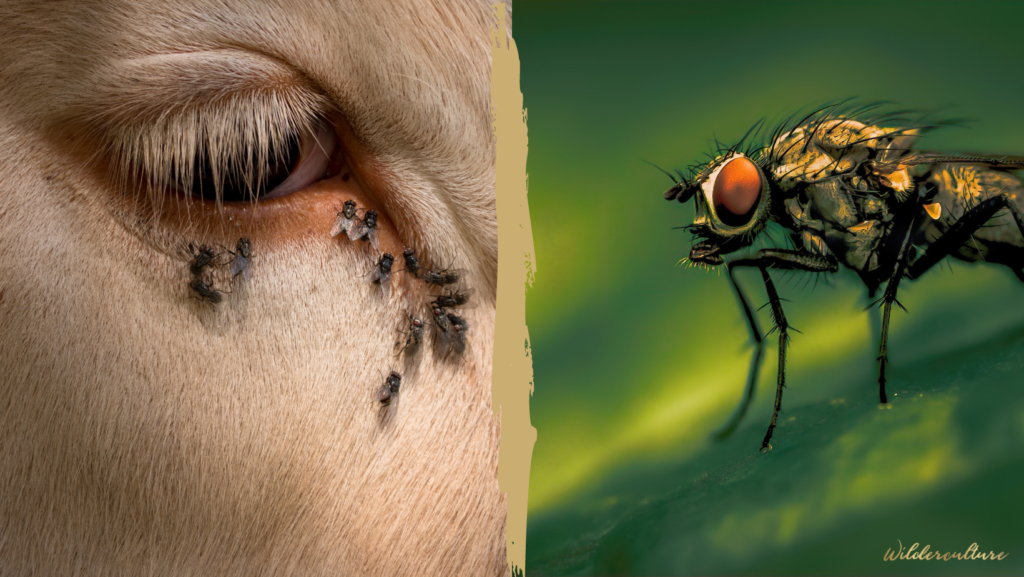
What New Forest eye as a Red Flag indicator is showing us?
The first thing that the team realised is that there were a lot of flies. This particular species of fly lays eggs on fresh dung pats and after a couple of weeks in a larval stage, the fly emerges.
There are many species of birds, invertebrates and beetles, in particular dung beetles, that will predate on the fly eggs, (there are many more creatures that will break up dung pats, hens are particularly good at this, as they look for larvae to eat).
This led the team to analyse in what way their management was inhibiting the existence of insects such as dung beetles. They realised that the prophylactic use of parasiticides in the sheep, in particular intestinal wormers containing avermectins, and treatments for flystrike, were having non-target effects on all other insects, poisoning insects such as dung beetles. So they started looking at the way in which they might change management of the sheep in order to reduce the need for such treatments. This included multi paddock grazing, grazing taller swards and shearing earlier in the year.
Within a regenerative transition, diversity should always be increasing and with it, red flag species are likely to become less prevalent. Nature will also throw up spontaneous, unexpected solutions from this diversity pool.
Liver Fluke
Liver fluke is caused by Fasciola hepatica and is on the increase, as is resistance to some treatments. Cattle, sheep, deer, hares, rabbits and horses can all be infected.
Like ticks, liver fluke has a complex life cycle: eggs from the faeces of infected cattle or other hosts, hatch and seek the dwarf pond snail as their next host. Inside the snail they develop into an encysted form which then attaches to vegetation. There it can survive for months, waiting to be ingested by a herbivore. Once inside the digestive system, the fluke migrates from the gut to the liver then to the bile duct that runs through the liver, where once mature it will lay eggs.
Chronic symptoms of liver fluke include weight loss and loss of condition. Acute symptoms (seen in sheep) include blood loss.
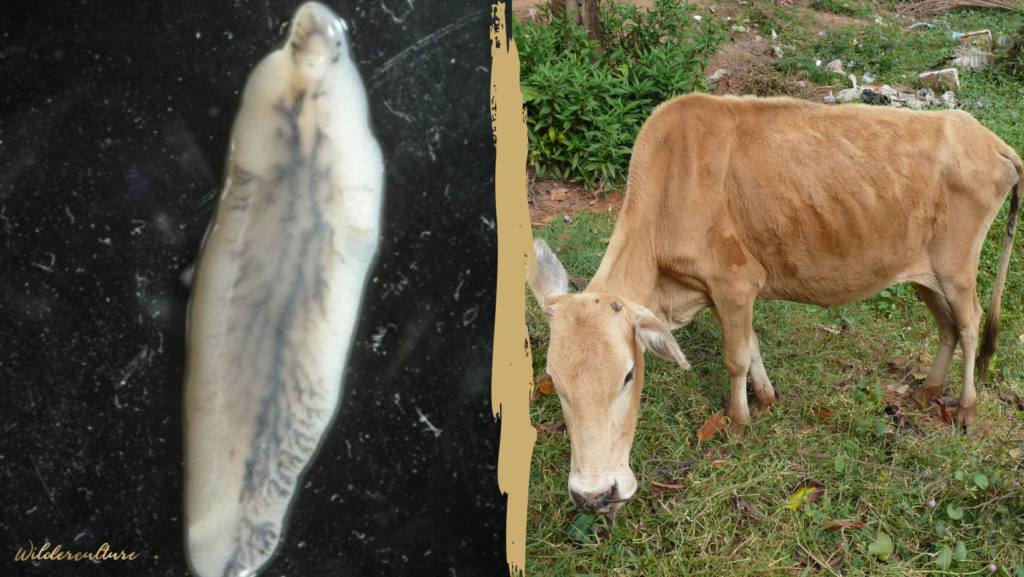
What can we do in a regenerative system to reduce the prevalence of liver fluke?
Firstly let’s look at the environment. What are we doing in our management to create the conditions for fluke to thrive? Fluke requires wet conditions, so planning grazing rotations, allowing grass to grow tall and not grazing it more than 50% will help increase soil health and biology and therefore the correct function of the water cycle. Surface water will diminish as a healthy carbon-sponge develops increasing the soil’s ability to hold water. Healthier soil will also see water flow into subsoils rather than sit on the surface. If trees were to be introduced into the pasture and ponds dug, this would help this process even more, creating ever greater diversity.
This diversification of the habitat will increase the natural predators of the dwarf pond snail. This could also be helped with the addition of fowl species that also predate on the snails, such as ducks, geese and hens.
The other perspective from which to examine this problem is to look at the host animal’s ability to respond to infection and avoid disease associated with liver fluke. Self-medication in wildlife species allows host-parasite relationships to co-evolve in a manner that reduces the likelihood of inevitable and/or severe disease in hosts. However there may be a number of barriers to this for domesticated species:
- Having access to a wide variety of plants so that they might find what they need. The diversification of the ecosystem therefore, could potentially have enormous benefits to this aspect of treating fluke.
- Having the knowledge of what plants to eat for such purposes. This knowledge, nutritional wisdom is a learned behaviour. It requires that young animals spend time with their mothers and wider family groups in a diverse habitat where nature’s dynamic networks are intact. It also requires breeds that have retained this instinctive behaviour.
- Having intergenerational groups also helps, because older animals will have some resistance to fluke where youngsters don’t. If we put only young, fully susceptible animals into a field, then we are, yet again, simplifying the system and giving the advantage to the red flag species.
Animals like horses, when restricted to grazing in one field, will create toilet zones in which to defecate – areas in which they will then not feed. This is part of their instinctive behaviour to guard against internal parasites.
Conclusion
When we simplify an ecosystem we create gapping niches within which certain species will thrive and often become a problem.
If we promote diversity then nature’s dynamic networks can reconnect and become ever more complex making it far more difficult for problem species to get out of balance in this way.
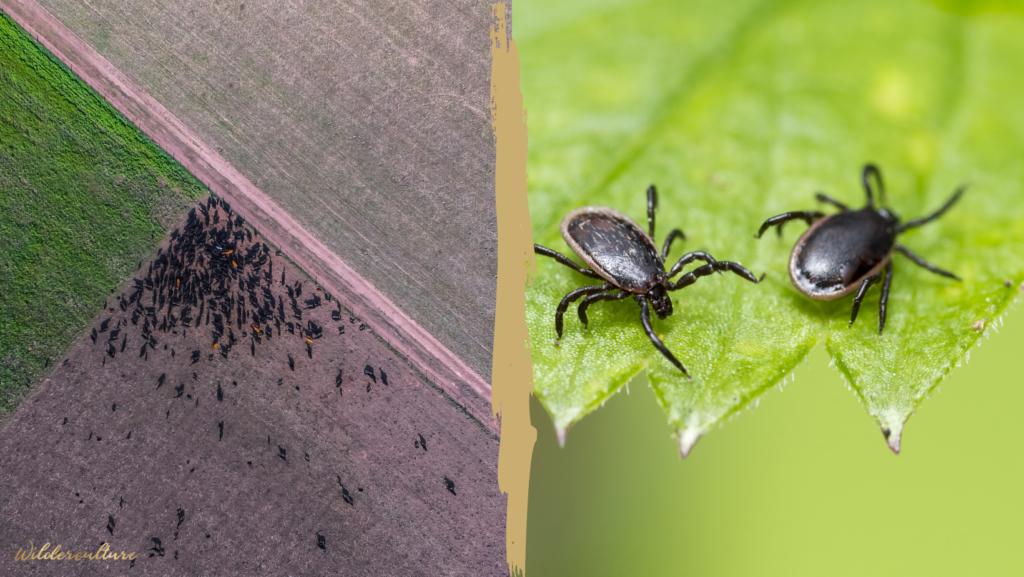
The diversity of all ecosystems starts with the soil so management that regenerates the soil is essential. You can read more about this in other articles on the blog.
———————
In the third and final article on Red Flag Species, we will look at the topic from the perspective of rewilding, whole-ecosystem and wildlife.


No Comments